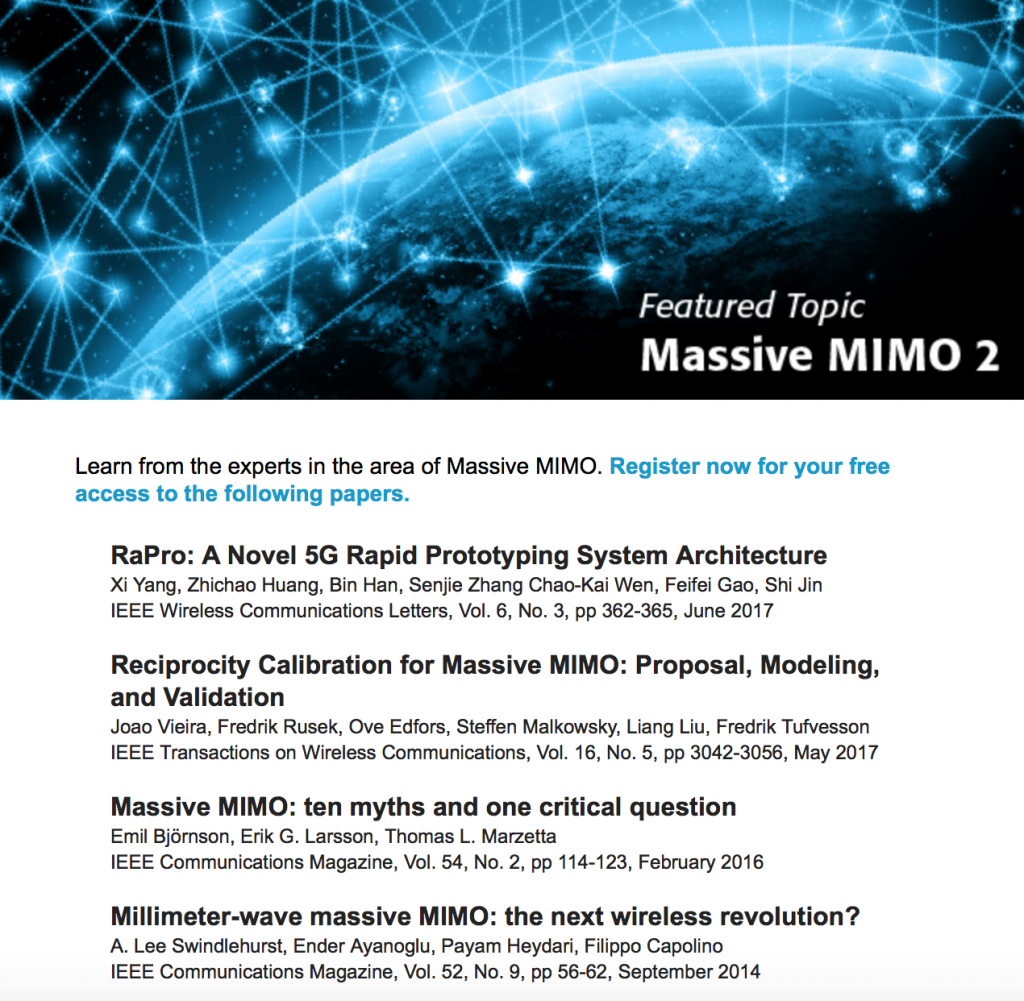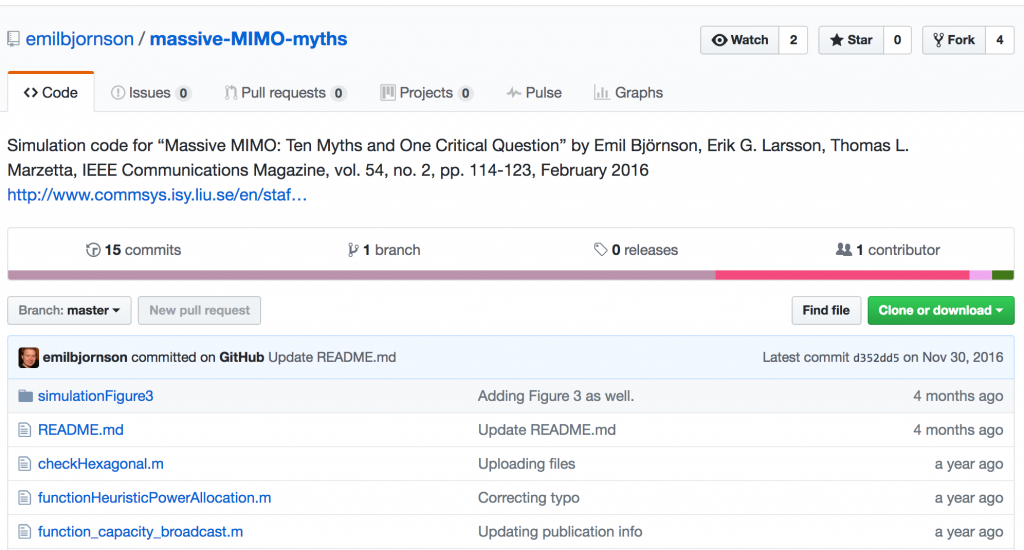Here are the video recordings of the lectures and keynotes from the Joint IEEE SPS and EURASIP Summer School on Signal Processing for 5G.
IEEE SPS members can watch the videos for free but it is necessary to log in through the IEEE website.
Here are the video recordings of the lectures and keynotes from the Joint IEEE SPS and EURASIP Summer School on Signal Processing for 5G.
IEEE SPS members can watch the videos for free but it is necessary to log in through the IEEE website.
IEEE ComSoc provides new online material every month and in August the focus is on Massive MIMO.
First, four carefully selected articles are offered free of charge, see the screenshot below and click here for details.

More precisely, IEEE offers free access to the published versions of these articles, while the accepted versions were already openly available: Paper 1, Paper 2, Paper 3, and Paper 4.
Second, a live webinar entitled “5G Massive MIMO: Achieving Spectrum Efficiency” is organized by IEEE ComSoc on August 24. The speaker is Professor Liesbet Van der Perre from KU Leuven. She was the scientific leader of the MAMMOET project, which is famous for demonstrating that Massive MIMO works in practice. You can expect a unique mix of theoretical concepts and practical implementation insights from this webinar.
Reproducibility is fundamental to scientific research. If you develop a new algorithm and use simulations/experiments to claim its superiority over prior algorithms, your claims are only credible if other researchers can reproduce and confirm them.
The first step towards reproducibility is to describe the simulation procedure in such detail that another researcher can repeat the simulation, but a major effort is typically needed to reimplement everything. The second step is to make the simulation code publicly available, so that any scientist can review it and easily reproduce the results. While the first step is mandatory for publishing a scientific study, there is a movement towards open science that would make also the second step a common practice.
I understand that some researchers are skeptical towards sharing their simulation code, in fear of losing their competitive advantage towards other research groups. My personal principle is to not share any code until the research study is finished and the results have been accepted for publication in a full-length journal. After that, I think that the society benefits the most if other researcher can focus on improving my and others’ research, instead of spending excessive amount of time on reimplementing known algorithms. I also believe that the primary competitive advantage in research is the know-how and technical insights, while the simulation code is of secondary importance.

On my GitHub page, I have published Matlab code packages that reproduces the simulation results in one book, one book chapter, and more than 15 peer-reviewed articles. Most of these publications are related to MIMO or Massive MIMO. I see many benefits from doing this:
1) It increases the credibility of my research group’s work;
2) I write better code when I know that other people will read it;
3) Other researchers can dedicate their time into developing new improved algorithms and compare them with my baseline implementations;
4) Young scientists may learn how to implement a basic simulation environment by reading the code.
I hope that other Massive MIMO researchers will also make their simulation code publicly available. Maybe you have already done that? In that case, please feel free to write a comment to this post with a link to your code.
In January this year, the IEEE Signal Processing Magazine contained an article by Erik G. Larsson, Danyo Danev, Mikael Olofsson, and Simon Sörman on “Teaching the Principles of Massive MIMO: Exploring reciprocity-based multiuser MIMO beamforming using acoustic waves“. It describes an exciting approach to teach the basics of Massive MIMO communication by implementing the system acoustically, using loudspeaker elements instead of antennas. The fifth-year engineering students at Linköping University have performed such implementations in 2014, 2015, and 2016, in the form of a conceive-design-implement-operate (CDIO) project.
The article details the teaching principles and experiences that the teachers and students had from the 2015 edition of the CDIO-project. This was also described in a previous blog post. In the following video, the students describe and demonstrate the end-result of the 2016 edition of the project. The acoustic testbed is now truly massive, since 64 loudspeakers were used.
If you want to learn about signal processing foundations for Massive MIMO and mmWave communications, you should attend the
2017 Joint IEEE SPS and EURASIP Summer School on Signal Processing for 5G
Signal processing is at the core of the emerging fifth generation (5G) cellular communication systems, which will bring revolutionary changes to the physical layer. Unlike other 5G events, the objective of this summer school is to teach the main physical-layer techniques for 5G from a signal-processing perspective. The lectures will provide a background on the 5G wireless communication concepts and their formulation from a signal processing perspective. Emphasis will be placed on showing specifically how cutting-edge signal processing techniques can and will be applied to 5G. Keynote speeches by leading researchers from Ericsson, Huawei, China Mobile, and Volvo complement the technical lectures.
The summer school covers the following specific topics:
The school takes place in Gothenburg, Sweden, from May 29th to June 1st, in the week after ICC in Paris.
This event belongs to the successful series of IEEE SPS and EURASIP Seasonal Schools in Signal Processing. The 2017 edition is jointly organized by Chalmers University of Technology, Linköping University, The University of Texas at Austin, Aalborg University and the University of Vigo.
Registration is now open. A limited number of student travel grants will be available.
For more information and detailed program, see: http://www.sp-for-5g.com/
Our Cambridge book, Fundamentals of Massive MIMO, ships now from all major retailers.
Problem set: We have developed an extensive set of problems to go with the book. This problem set can be downloaded from the Cambridge resource page, www.cambridge.org/Marzetta, or from this direct link.
The difficulty level of the problem varies widely, rendering the material suitable for instruction at all levels. The problem set is very much a living document and may be extended or improved in the future. Many, though not all, of the problems have been tested on my students when I taught the subject last year. We appreciate, as always, comments or suggestions on the material.
A detailed solution manual is available to instructors who adopt the book.
List of errata: There is also a list of errata to the book – available via this direct link, or from the Cambridge resource page.
Have no fear of perfection — you’ll never reach it. — Salvador Dali